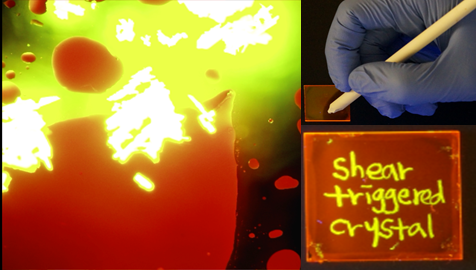Light it up: Materials crystallize with surprising properties

Think about your favorite toys as a child. Did they light up or make funny noises when you touched them? Maybe they changed shape or texture. Today in ACS Central Science, researchers report a new material that combines many of these characteristics. Beyond being fun, these materials, called organic "supercooled" liquids, may be useful for optical storage systems and biomedical sensors.
Some materials, like ordinary table salt, are crystals. When most crystals are heated up and then cooled again, they recrystallize. A few others don't quite snap back to their original well-ordered crystals when cooled but form amorphous supercooled liquids. For certain applications such as organic electronics and pharmaceutics, thermally stable amorphous organic materials are very important for device reliability and consistent efficacy. To better understand these processes, Jinsang Kim and colleagues investigated how modifications of molecular structure can provide unique thermal stability to molten organic liquid in a wide temperature range.
The researchers studied a chemical called DPP, which has been widely used in dyes and organic electronics applications. They found that when two balanced intermolecular interaction forces implemented in DPP molecules are working toward opposite directions, the DPP remains in a uniquely stable supercooled liquid state. Interestingly, a small "shear force" (getting rubbed) can break the force balance and induce rapid crystallization with a color change and bright "glow" under UV light. They say that their work has provided an understanding about molecular features that could be used to create thermally stable supercooled liquids.
More information: Shear-triggered Crystallization and Light Emission of a Thermally Stable Organic Supercooled Liquid, ACS Cent. Sci., Article ASAP. DOI: 10.1021/acscentsci.5b00091
Abstract
Thermodynamics drive crystalline organic molecules to be crystallized at temperatures below their melting point. Even though molecules can form supercooled liquids by rapid cooling, crystalline organic materials readily undergo a phase transformation to an energetically favorable crystalline phase upon subsequent heat treatment. Opposite to this general observation, here, we report molecular design of thermally stable supercooled liquid of diketopyrrolopyrrole (DPP) derivatives and their intriguing shear-triggered crystallization with dramatic optical property changes. Molten DPP8, one of the DPP derivatives, remains as stable supercooled liquid without crystallization through subsequent thermal cycles. More interestingly, under shear conditions, this supercooled liquid DPP8 transforms to its crystal phase accompanied by a 25-fold increase in photoluminescence (PL) quantum efficiency and a color change. By systematic investigation on supercooled liquid formation of crystalline DPP derivatives and their correlation with chemical structures, we reveal that the origin of this thermally stable supercooled liquid is a subtle force balance between aromatic interactions among the core units and van der Waals interactions among the aliphatic side chains acting in opposite directions. Moreover, by applying shear force to a supercooled liquid DPP8 film at different temperatures, we demonstrated direct writing of fluorescent patterns and propagating fluorescence amplification, respectively. Shear-triggered crystallization of DPP8 is further achieved even by living cell attachment and spreading, demonstrating the high sensitivity of the shear-triggered crystallization which is about 6 orders of magnitude more sensitive than typical mechanochromism observed in organic materials.
Provided by American Chemical Society




















